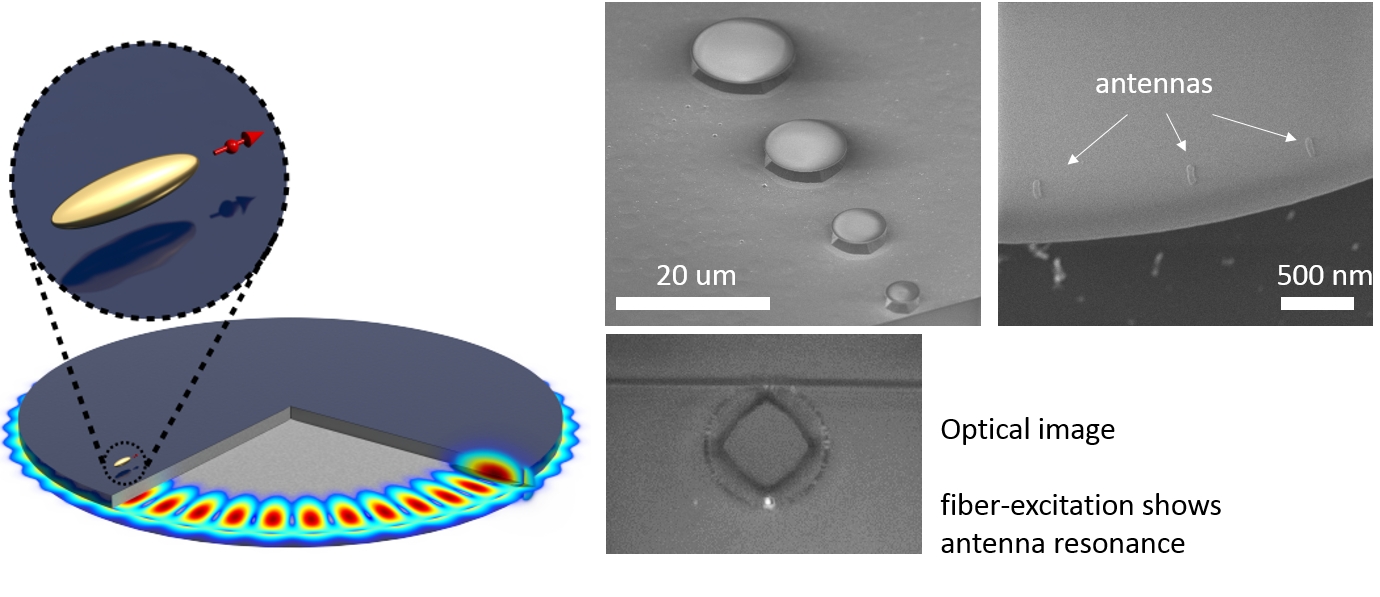State of the art nanophotonics either uses ultra-high Q microcavities or alternatively broadband plasmonic antennas to achieve strong coupling between photons and matter for enhanced lighting, lasers, single photon sources and strong coupling quantum optics with single emitters. Both approaches face huge bottlenecks that hamper these applications, in particular solid state quantum optics: The ultranarrow bandwidth (1 ppm) of high Q microcavities imposes very slow response times, and requires intricate stabilization and tuning that is not scalable to many-node quantum networks. On the other hand, plasmonics is so broadband that it is impractical for spectral selectivity, and adds huge absorptive losses.

Hybrids of plasmonics and microcavities:
We pursue a novel solution to remove these bottlenecks coined “hybrid antenna QED”. Plasmon antennas placed inside dielectric resonators will allow to reach very strong light-matter interaction at practical quality factors (Q ~ 100-1000), thereby creating a platform for ultrafast nanophotonic integrated quantum optics. Due to the fundamental physics of how the modes of nanoscale plasmon structures hybridize [53], [59], [80] with those of dielectric resonators, such as photonic crystal cavities, this platform will have breakthrough figures of merit [93] for enhanced lightmatter interaction, nonlinear optics and strong coupling quantum optics. By integrating the hybrid antenna QED systems with single emitters using nanolithography and nanomechanical manipulation techniques, one could ultimately envision single photon sources, detectors, sensors and nonlinear elements that operate over THz bandwidth and can be manipulated on ultrafast time scales.

See:
| [93] | H. M. Doeleman, E. Verhagen, and A. F. Koenderink, Antenna-Cavity Hybrids: Matching Polar Opposites for Purcell Enhancements at Any Linewidth, ACS Photonics 3, 1943–1951, (2016). | (p)reprint DOI |
| [80] | F. Ruesink, H. M. Doeleman, R. Hendrikx, A. F. Koenderink, and E. Verhagen, Perturbing Open Cavities: Anomalous Resonance Frequency Shifts in a Hybrid Cavity-Nanoantenna System, Phys. Rev. Lett. 115, 203904, (2015). | (p)reprint DOI |
| [59] | M. Frimmer and A. F. Koenderink, Spontaneous Emission Control in a Tunable Hybrid Photonic System, Phys. Rev. Lett. 110, 217405, (2013). | (p)reprint DOI |
| [53] | M. Frimmer and A. F. Koenderink, Superemitters in Hybrid Photonic Systems: A Simple Lumping Rule for The Local Density of Optical States and Its Breakdown at the Unitary Limit, Phys. Rev. B 86, 235428, (2012). | (p)reprint DOI |
